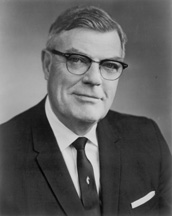
Joseph Henry Bottum was an American politician. He served as the 27th Lieutenant Governor of South Dakota and as a member of the United States Senate from South Dakota.

The Attorney General of South Dakota is the state attorney general of the U.S. state of South Dakota. The attorney general is elected by popular vote to a four-year term and holds an executive position as the state's chief legal officer. In 1992, the voters approved a Constitutional Amendment to limit all constitutional officers and the governor to two consecutive four year terms.

The 1970 Arkansas gubernatorial election was held on November 3, 1970.

The 1968 South Dakota gubernatorial election was held on November 5, 1968.

The 1958 South Dakota gubernatorial election was held on November 4, 1958.

The 2022 South Dakota gubernatorial election will take place on November 8, 2022, to elect the governor of South Dakota. Incumbent Republican governor Kristi Noem is running for a second term.

The 1952 Arkansas gubernatorial election was held on November 4, 1952.

The 1950 Wisconsin gubernatorial election was held on November 7, 1950.

The 1948 Wisconsin gubernatorial election was held on November 2, 1948.

The 1946 Texas gubernatorial election was held on November 5, 1946.

The 1944 Texas gubernatorial election was held on November 7, 1944.

The 1946 Wisconsin gubernatorial election was held on November 5, 1946.

The 1948 South Dakota gubernatorial election was held on November 2, 1948. Incumbent Republican Governor George T. Mickelson ran for re-election to a second term. He was opposed by Democrat Harold J. Volz, a businessman and the former Chairman of the Tripp County Democratic Party. Both Mickelson and Volz were the only candidates of their parties to file for Governor, ensuring that they won their respective nominations unopposed and removing the race from the primary ballot. In the general election, Mickelson had little difficulty defeating Volz. Though Republican presidential nominee Thomas E. Dewey only narrowly won the state over President Harry S. Truman, Mickelson's popularity allowed him to win re-election in a landslide, receiving 61% of the vote to Volz's 39%.

The 1944 Wisconsin gubernatorial election was held on November 7, 1944.

The 1916 South Dakota gubernatorial election was held on November 7, 1916. Incumbent Republican Governor Frank M. Byrne declined to seek re-election to a third term. Lieutenant Governor Peter Norbeck won the Republican primary to succeed him, and in the general election faced State Representative Orville V. Rinehart. Norbeck won his first term as Governor in a landslide over Rinehart.

The 1940 Wisconsin gubernatorial election was held on November 5, 1940.

The 1936 Wisconsin gubernatorial election was held on November 3, 1936.

The 1944 South Dakota gubernatorial election was held on November 7, 1944. Incumbent Republican Governor Merrell Q. Sharpe ran for re-election to a second term. He was opposed Lynn Fellows, a former State Representative from Aurora County the 1942 Democratic nominee for Attorney General, in the general election; both Sharpe and Fellows won their primaries unopposed. In the general election, Sharpe easily defeated Fellows, far outpacing even Republican presidential nominee Thomas E. Dewey, who won the state in a landslide.

The 1918 South Dakota gubernatorial election was held on November 5, 1918. Incumbent Republican Governor Peter Norbeck ran for re-election to a second term. He won the Republican primary unopposed and faced Nonpartisan League candidate Mark P. Bates, a farmer, and Democratic nominee James E. Bird in the general election. Norbeck's share of the vote decreased from 1916 to 53%, but he benefited from the split field. Bates placed second with 26% of the vote, while Bird placed third with 19% of the vote.

The 1942 South Dakota gubernatorial election was held on November 3, 1942. Incumbent Republican Governor Harlan J. Bushfield declined to seek re-election to a third term and instead successfully ran for the U.S. Senate. A crowded Republican primary developed to succeed him, and because no candidate received 35% of the vote, the nomination was decided at the state Republican convention, where former Attorney General Merrell Q. Sharpe, the second-place finisher in the primary, won the nomination. In the general election, Sharpe faced Democratic nominee Lewis W. Bicknell, the 1940 Democratic nominee for Governor. Aided by the national Republican landslide, Sharpe defeated Bicknell in a landslide.

















